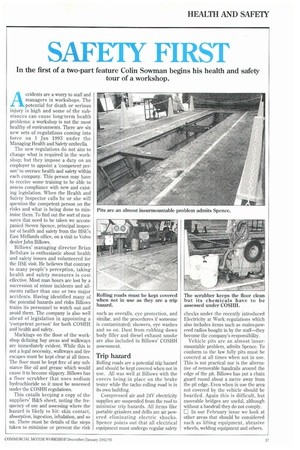SAFETY FIRST
Page 93

If you've noticed an error in this article please click here to report it so we can fix it.
In the first of a two-part feature Colin Sowman begins his health and safety tour of a workshop.
Accidents are a worry to staff and managers in workshops. The potential for death or serious injury is high and some of the substances can cause long-term health problems: a workshop is not the most healthy of environments. There are six new sets of regulations coming into force on 1 Jan 1993 under the Managing Health and Safety umbrella.
The new regulations do not aim to change what is required in the workshop; but they impose a duty on an employer to appoint a 'competent person' to oversee health and safety within each company. This person may have to receive some training to be able to assess compliance with new and existing legislation. When the Health and Safety Inspector calls he or she will question the competent person on the risks and what is being done to minimise them. To find out the sort of measures that need to be taken we accompanied Steven Spence, principal inspector of health and safety from the HSE's East Midlands office, on a visit to Volvo dealer John Billows.
Billows' managing director Brian Bellshaw is enthusiastic about health and safety issues and volunteered for the HSE visit. He believes that contrary to many people's perception, taking health and safety measures is cost effective. Most man hours are lost by a succession of minor incidents and ailments rather than one or two major accidents. Having identified many of the potential hazards and risks Billows trains its personnel to watch out and avoid them. The company is also well ahead of legislation in appointing a 'competent person for both COSHH and health and safety.
Markings on the floor of the workshop defining bay areas and walkways are immediately evident. While this is not a legal necessity, walkways and lire escapes must be kept clear at all times. The floor must be kept free of any substance like oil and grease which would cause it to become slippery. Billows has a floor scrubber that uses sodium hydrochloride so it must be assessed under the COSHH regulations.
This entails keeping a copy of the suppliers' H&S sheet, noting the frequency of use and assessing where the hazard is likely to hit: skin contact, absorption, ingestion, inhalation, and so on. There must be details of the steps taken to minimise or prevent the risk such as overalls, eye protection, and similar, and the procedures if someone is contaminated; showers, eye washes and so on. Dust from rubbing down body filler and diesel exhaust smoke are also included in Billows' COSHH assessment.
Trip hazard
Rolling roads are a potential trip hazard and should be kept covered when not in use. All was well at Billows with the covers being in place on the brake tester while the tacho rolling road is in its own building.
Compressed air and 24V electricity supplies are suspended from the roof to minimise trip hazards. All items like portable grinders and drills are air powered eliminating electric shocks. Spence points out that all electrical equipment must undergo regular safety checks under the recently introduced Electricity at Work regulations which also includes items such as mains-powered radios bought in by the staff—they become the company's responsibility.
Vehicle pits are an almost insurmountable problem, admits Spence. To conform to the law fully pits must be covered at all times when not in use. This is not practical nor is the alternative of removable handrails around the edge of the pit. Billows has put a chain guard round about a metre away from the pit edge. Even when in use the area not covered by the vehicle should be boarded. Again this is difficult, but moveable bridges are useful, although without a handrail they do not comply. E In our February issue we look at other areas that should be considered such as lifting equipment, abrasive wheels, welding equipment and others.




































































































